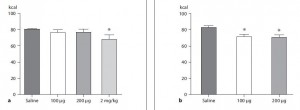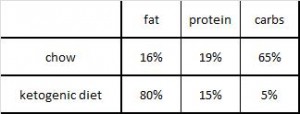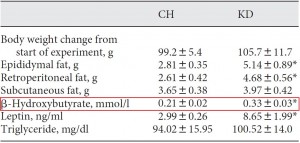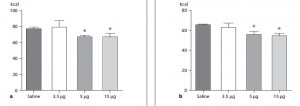Episode 1 of the ketosis series
Ketosis vs. leptin
My current running hypothesis, based on a few rodent-diet studies, is that leptin resistance is mediated entirely by sugar and is not influenced by dietary fat. The relationship between leptin resistance and obesity is somewhat less clear (does leptin resistance cause hyperphagia and obesity? does hyperphagia and obesity cause leptin resistance? The latter example seems odd, but it would imply that leptin resistance develops after the onset of obesity… which would be supported by the observation of leptin sensitive obesity (e.g., here)
The study discussed below is another example of obesity sans leptin resistance. To review, leptin resistance can occur without obesity on a high fructose diet, but it does not occur on a sugar free high fat diet.
Sensitivity to the anorectic effects of leptin is retained in rats maintained on a ketogenic diet despite increased adiposity (Kinzig et al., 2010 Neuroendocrinology)
Unfortunately, this was a pretty bad “diet” study from a nutrition perspective because there are way too many variables. Are the results due to increased dietary fat? lower protein? lower carbs? Aargh. We will never know because they were all manipulated and uncontrolled. (psychologists and neuroscientists should NOT be allowed to design nutrition experiments). Even the types of protein and fat were different between the groups.
This study in a nutshell: leptin sensitivity and various other metabolic parameters were measured in rats fed chow or a ketogenic diet.
Divide and conquer.
What is a ketogenic diet?
A ketogenic diet is insulinopenic = low carb, high fat. The biochemical signature is elevated serum ketone bodies. ?-hydroxybutyrate (red box in the table above) is the most abundant, and its elevation in the ketogenic diet-fed rats (KD) confirms that indeed, this was a ketogenic diet (note, b-Hb @ 0.33 mM is a very mild ketosis).
Unfortunately, these authors quantified fat mass by tissue excision and weighing, which is an inferior and inaccurate technique. However, since the fat mass and leptin data* concur, we can infer KD rats were probably a little fatter by the end of the study.
*Leptin increases when fat mass increases.
Leptin sensitivity was measured by injecting leptin i.p. and measuring food intake for the next 24 hours. Higher leptin sensitivity results in a greater reduction in food intake. As seen in the figures below, chow-fed rats (figure a, on the right) were more leptin resistant than KD rats (figure b, on the right). 
In fact, KD rats responded to 100 ug of leptin whereas it took almost 6 times more (2 mg/kg = ~600ug) to achieve a similar reduction in chow-fed rats.
One minor critique: the authors believed that a key novel finding of their study was that KD rats were more leptin sensitive despite being fatter… Given that adiposity was such a critical factor in their conclusion, they should have used something better than the worst way to measure fat mass. Thus, a weak point of this study is that the validity of the conclusion (which is also in the title of the paper) is based on a notoriously inaccurate technique.
Interestingly, despite exhibiting resistance to peripherally administered leptin (above), chow-fed (below, figure a) rats were equally sensitive to KD rats (figure b) when leptin was centrally administered (i.c.v.):
The authors proceeded to speculate that leptin is less able to cross the blood-brain barrier in chow fed rats compared to KD. It’s possible. One theory on the mechanism of leptin resistance states that elevated triacylglycerols impair leptin’s ability to cross the BBB. This is probably not true, as KD rats were more leptin sensitive despite having higher triacylglycerols. $
One more minor critique, which I only mention because this issue arises frequently and is often ignored. although I still don’t know what it means:
1) If KD rats were significantly more sensitive to leptin, why was their 24h food consumption similar to chow-fed rats? (see saline injections in any of the figures above and here)
2) Leptin levels in KD rats were significantly higher than those in chow-fed rats (8.65 vs. 2.99 ng/mL). If they were indeed more leptin sensitive, then shouldn’t their food intake been lower than chow-fed rats?
3) KD rats had significantly higher leptin levels (8.65 vs. 2.99 ng/mL). So injecting KD rats with 100ug leptin increased their leptin from 8.65 ng/mL to 8.65 + X. Whereas injecting chow rats with 100ug leptin increased their leptin from 2.99 to 2.99 + X. Since “8.65 + X” will always be mathematically greater than “2.99 + X,” circulating leptin in the KD rats injected with 100ug of leptin should have been significantly greater than circulating leptin in chow-fed rats injected with 100ug leptin, so KD rats would have ingested less than chow-fed rats even if they were equally leptin sensitive. As such, I don’t think it’s proper to conclude, from those experiments alone, that KD rats were more leptin sensitive. $$
3.5) Is there a difference between endogenous and exogenous leptin? I.e., is exogenous leptin stronger than endogenous leptin? If so, this is very important. Food for thought.
calories proper



